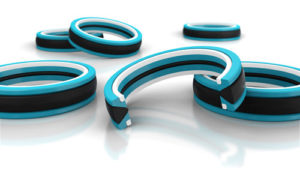
The upcoming IFPE show, in Las Vegas from March 7-11, will allow fluid power designers to see the latest in sealing technology—a constantly evolving part of the industry. Following is a description of how they’re used in mobile machinery, as well as a listing of what IFPE booths you can visit for more information on seals.
Seals are the unsung heroes of the fluid power industry; they work hard in nearly every conceivable pump, valve or actuator, providing function, efficiency and reliability far exceeding their cost or complexity. For such a simple invention, the seal exists in countless configurations, often with nearly imperceptible differences, but different all the same. They seal shafts, spools, plates, pistons, rods and nearly every location with moving parts or between two locations of opposed pressure or fluid.
The two major classifications of seals are dynamic and static. Dynamic seals must keep pressure contained as one surface slides across or rotates around another surface, such as rod seals, shaft seals and piston seals. They are most often cup-shaped to take advantage of pressure to increase sealing. Static seals, such as O-rings or gaskets, are used to separate two areas of a component, such as a reservoir lid or spool valve end covers.
Seal construction has come a long way, the majority of which are now of synthetic construction—Viton, Buna N or Teflon, to name a few. Seal composition needs to reflect the fluid used. Buna is fine for mineral oil, but Viton is required for exotic fluids such as glycols or esters. The shape of the seal is usually dictated by the location of its use. A piston seal typically has the cross-section appearance of a “U.” As you can imagine, pressure inside the middle of the U pushes the edges outward, with extra pressure creating extra sealing.
The traditional O-ring is still very common; although less common these days in dynamic or high-pressure applications, it can still be found in countless applications, such as pump rear-covers or ISO valve mounting. Most high pressure O-ring applications used for static pressure holding require a back-up washer, typically of Teflon, which prevents the O-ring from being extruded out the lower pressure side. Nearly every cartridge valve, for example, uses the O-ring/back-up washer configuration.
Seals are typically measured by their cross section width, their ID and their OD. Metric and SAE sizes are both common, and although component manufacturers offer rebuild kits with a complete set of seals (for cylinders, pumps etc), any competent technician can quickly measure up seals to be purchased through third-party sources.
Seal manufacturers & suppliers at IFPE
AAH Fluid Power Inc. S83046
Air-Way Manufacturing S83205
Brennan Industries S82002
Caplugs S81416
DDKS Industries S80054
Duci S.r.l. S83151
Elesa USA Corp S82635
ESP International S80051
Essentra Components S82334
Fluorten S.r.l. S83151
Freudenberg S82630
Henkel Corp. S60115
Hercules Sealing Products S80356
Kastas Sealing Technologies A.S. S82605
Lee Co. S81252
MFP Seals S82330
Mocap Inc. S80650
Noshok Inc. S83146
Oringone S.r.l. S83151
Parker Hannifin S80242
Polymer Molding Inc. S82041
Royal Composites Pvt Ltd. S81316
T-Lon Products S82034
Tifco Industries S83705
Trelleborg Sealing Solutions S81616


Leave a Reply